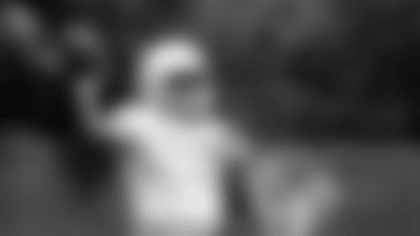Welcome to Dan Riley's ninth installment of Texans Fitness Corner. The response continues to be overwhelming. We will continue to post selected answers to your questions throughout the year. Join in by shooting over an e-mail to fitness@houstontexans.com.
NOTE:Before engaging in any new physical activity, always consult your physician.
**
I'm 19 years old and in the coast guard. I have worked out infrequently during the past year. I mainly work out my upper body. My plan is to get back in the gym. Do you have any advice for me?
I have also heard that push-ups and sit-ups can be bad for you. I like doing pushups and sit-ups. What is your opinion? I used to work out every other day and do pushups and sit-ups on the days I didn't work out in the gym. but any advice you can give me would be appreciated.
-- Tre **
My first bit of advice is, when you get back in the gym I'd recommend you train the entire body, not just your upper body. General overall muscular strength and endurance can significantly improve the quality of your life, as you grow older. Don't ignore your lower body.
Any exercise can be bad if it is performed improperly, or, it causes or aggravates an injury. If performed properly, pushups and sit-ups can be productive movements.
The chest (pectorals), shoulders (deltoids), and triceps (back of the upper arm), are the prime movers when performing a pushup. We periodically implement a set of pushups in our player's routine to create some variety. You can vary how the pushup is performed.
You can vary the degree of difficulty and the muscle group to be emphasized. To place a greater emphasis on your triceps try one of the following.
- Move your hands (width of your grip) closer together.
- Rotate your hands inward to a position where your fingers are at about a 45-degree angle and almost touching.
- Perform any isolation triceps movement followed immediately by a set of conventional pushups.
For variety, I have our players perform a set of triceps extension (on a lat machine) immediately followed by a set of pushups. When they do the pushup I stand over and straddle the player. I manually add resistance to their upper back while they perform the pushups. If they can't continue the exercise in the conventional pushup position we have them drop to their knees to finish the set. I call them power pushups. Our players call them "unjust torture."
Performing the triceps extension first will magnify the degree of emphasis on the triceps. The triceps extension will isolate and fatigue the triceps leaving the chest and shoulders fresh. By performing the pushup immediately after finishing the triceps extension, the chest and shoulders force the triceps to perform additional work in an already fatigued state.
If you are willing to work hard enough it feels like you're going to blow a hole in your triceps. I get called some pretty good names when I throw this little gem into the training session.
There are things you can do to increase the difficulty of the conventional pushup. If your goal is to improve, you must find a way to increase the degree of difficulty of the exercise. Progress will cease once your muscles adapt to your bodyweight.
Place your hands on a conventional scale while in the pushup position. Only a portion of your bodyweight registers on the scale because your feet are on the floor (taking some of the weight off your hands).
Find a way to elevate your feet six inches off the floor. You'll notice that more of your bodyweight registers on the scale. Continue to elevate your feet and the exercise becomes more difficult.
Most people look for ways to make an exercise easier (and less productive). They bounce their chest off the floor. To make the exercise harder you can place pads (books, anything sturdy) under your hands when you perform a pushup. This prevents your chest from touching the floor while increasing the range of motion and the degree of difficulty.
The power pushup (I previously described) is the most difficult way to perform a pushup. Assume the pushup position and have a spotter stand and straddle over you. The spotter will apply resistance manually to the upper back. The spotter must learn to apply the resistance in a smooth manner. Use caution the first few times you try this.
As the leverage of the exercise increases, the spotter should add more resistance accordingly. As the leverage decreases, the spotter should decrease the amount of resistance accordingly. Leverage improves as you straighten your arms. The spotter should gradually add more resistance as the arms are straightened.
Emphasize the lowering of the weight. Don't drop effortlessly to the floor. You can lower significantly more weight than you can lift. The spotter should therefore apply more resistance during the lowering phase. If you work hard enough, and your spotter adds the appropriate amount of resistance, you should reach the point where you can't perform another pushup in the conventional pushup position. This should take place somewhere between eight and ten reps. At this point you can stop or, drop to your knees and continue the exercise until you can't perform another rep in this position.
Take some time to develop the skill to add manual resistance to your training partner. Perform sub-maximal work before pushing each other to the maximum.
I wouldn't encourage performing pushups on your off day, unless you enjoy this protocol, and it doesn't interfere with your recovery from your lifting program.
We call sit-ups (the way most people do them) "throw ups and fall downs." People can be observed jerking their body up, by using the momentum of their head and arms snapping forward to help them sit up. They then effortlessly allow the upper body to fall back down performing little or no work.
The only concern is how many throw ups - I mean sit-ups - can they do. How they are performed is not a concern. The typical sit-up or crunch can be a very ineffective exercise. I've had people tell me, "I just did 500 crunches."
It can't be a very productive exercise if you need to perform 500 of anything. How productive is the first 400? I'm not saying don't do sit-ups or crunches. Do try and find ways to make them more difficult to execute.
Eliminate any sudden or jerky movements to help you sit up. In the starting position tuck the chin, round the upper back, cross the arms on the chest, bend the legs, and try to press the lower back down toward the floor. Keep the upper back rounded throughout the exercise.
Do not arch the back. Stop the exercise immediately if you feel any discomfort in the lower back.
Maintain this position throughout the exercise. Initiate the sit-up in a smooth manner. Slowly raise the body to a position where tension remains on the abdominal muscles, and pause momentarily in this position. Hold this position for a ½ count before slowly lowering the body to the starting position.
In the starting position you should feel tension on your abs. This will prevent the abs from resting between reps. Perform each rep in a slow and deliberate manner. Be more concerned with how you perform each rep rather than how many.
If you feel any discomfort in your lower back try straightening your arms and rest your palms on your thighs. As you sit up keep the arms straight and lightly slide your hands along your thighs. Try and sit up to a position where your wrists make contact with your knees. Pause in this position and slowly return to the starting position. Stop immediately if you continue to feel any discomfort in the lower.
You can use an ab board and elevate the angle. If an ab board is unavailable use a conventional chair. Lie on your back with the legs bent (90 degrees), and place the back of the legs on the chair. Have your partner sit on your legs to hold you down. Use the same techniques discussed above.
Try using an ab machine. It allows you to continue to use more weight, as your abdominals get stronger.
Remember, sit-ups are designed to develop the abdominal muscles, not burn away body fat. Spot reducing (losing fat in a localized area) is impossible. Fat loss must come from the entire body, not just from the area of excess.
Specific exercise for one part of the body will not eliminate fat from that area. Sit-ups will not "burn away" the excess fat from your abdominal region. If you want to "burn away" the fat you'd be better served to set your belly on fire. You can eliminate the fat over time with a balanced diet and burning more calories than you take in.
Tennis players over use one side of the body while serving, hitting the ball, and gripping the racquet. Yet when tested, the amount of body fat is identical on both sides of the body. The muscles on the dominant side are more developed but the amount of fat on both sides of the body remains the same.
Perform exercises to strengthen the abdominal muscles. Don't expect these exercises to rid the body of any excess fat.
Get back in the gym Tre, and enjoy the short and long term benefits of exercise. Pushups and sit-ups are good exercises if performed properly.
Go Texans!













